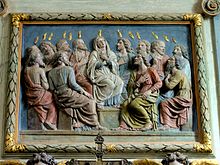Commeny
| Commeny | ||
|---|---|---|

|
|
|
| region | Île-de-France | |
| Department | Val d'Oise | |
| Arrondissement | Pontoise | |
| Canton | Pontoise | |
| Community association | Vexin Center | |
| Coordinates | 49 ° 8 ' N , 1 ° 54' E | |
| height | 67-126 m | |
| surface | 6.16 km 2 | |
| Residents | 483 (January 1, 2017) | |
| Population density | 78 inhabitants / km 2 | |
| Post Code | 95450 | |
| INSEE code | 95169 | |
| Website | Commeny | |
 Commeny - Église Saint-Martin |
||
Commeny is a place and a municipality in northern France with 483 inhabitants (as of January 1, 2017) in the Val-d'Oise department in the Île-de-France region ( France ).
location
The place Commeny is at an altitude of about 110 m above sea level. d. M. about 53 kilometers (driving distance) northwest of Paris in the landscape of the Vexin near the border with Normandy . The municipality is part of the Vexin français Regional Nature Park .
Population development
| year | 1800 | 1851 | 1901 | 1954 | 1999 | 2013 |
| Residents | 257 | 313 | 273 | 211 | 375 | 413 |
The increasing mechanization of agriculture has had little impact on the community's population. Due to the relative proximity to the greater Paris area and the significantly lower real estate prices in the countryside, the population has increased slightly again in recent decades.
economy
In earlier centuries the inhabitants lived on the produce of their fields and gardens as self-sufficient ; cattle breeding was also carried out on a small scale. Agriculture and retail trade continue to play a major role in the community's economic life. Some houses are designated as holiday homes ( gîtes ).
history
The Roman road Chaussée Jules César from Lutetia (Paris) to Rotomagus (Rouen) or to Juliobona ( Lillebonne ) led through the municipality in antiquity. The oldest traditional place name ( Cumencio ) comes from the High Middle Ages (1085 ); in a document from 1170 it is reported that the Abbey of Saint-Martin de Pontoise in Commeny owned property. The first verifiable church in the village was built around 1200 and was expanded in the 16th century.
Attractions
- The originally single-nave parish church of Saint-Martin was built around the year 1200. During the Hundred Years War (1337-1453) it was damaged and at the beginning of the 16th century it was decided to demolish the former outer walls and add two aisles . The bell tower dates from the 17th century, but was largely demolished and replaced in the 19th century. Church construction has been recognized as a monument historique since 1926 . The rib-vaulted interior contains several statues, two panel paintings from the 15th century and an altar relief depicting the Pentecostal miracle .
- The Ferme Saint-Jacques (or Ferme des Maillochins ) is an old farm with a barn, pigeon house etc .; it used to belong to the Église Saint-Jacques-de-la-Boucherie in Paris, which was destroyed in the revolutionary years except for the mighty bell tower .
- There is a bread museum ( Maison du pain ) in the village .
literature
- Le Patrimoine des Communes du Val-d'Oise. Flohic Éditions, Volume 2, Paris 1999, ISBN 2-84234-056-6 , pp. 990-992.
Web links
- Commeny, history - info (french)
- Commeny, Bread Museum - Photos + information (French)
Individual evidence
- ↑ Église Saint-Martin, Commeny in the Base Mérimée of the French Ministry of Culture (French)

